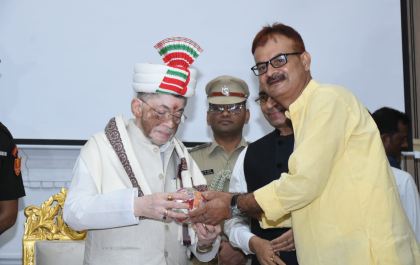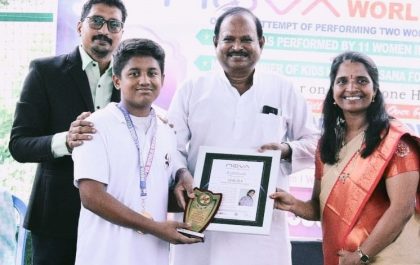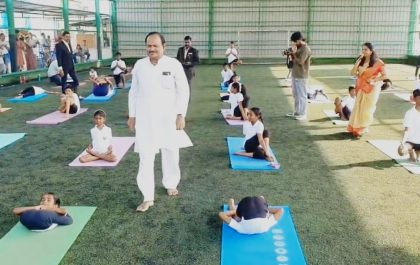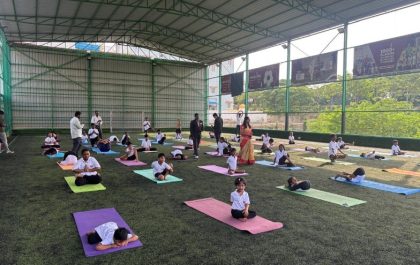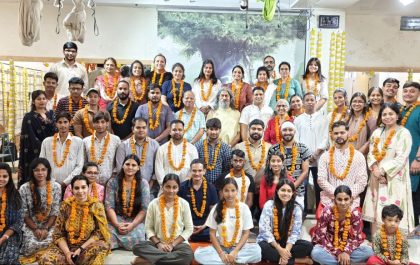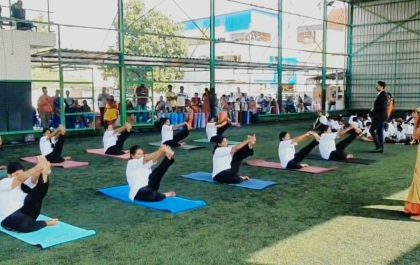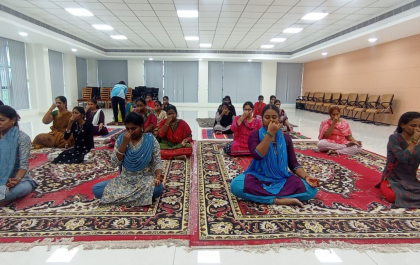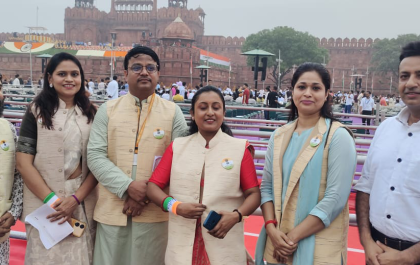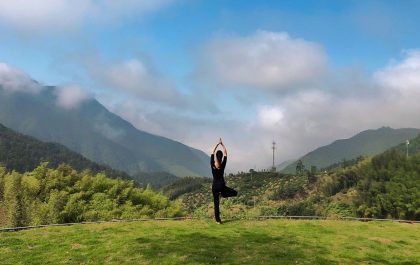by Shri Vinod Joshi, Trustee, Yoga Vidya Niketan
For every Yoga Student, it’s very important to learn Samkhya Philosophy, at least the basic concepts. This helps us to understand Patanjali Yoga sutras, thoroughly. Many scholars believe that Samkhya Philosophy lays the foundation of Yoga Philosophy. This is supported by the fact that Samkhya and Yoga are always clubbed together in studies of Shad-Darshanas of Indian Philosophical System.
In reality, most of the Yoga Sadhakas focus on mastering the Asanas and Pranayama. There is nothing wrong in it. However, depth of their sadhana and teachings will be improved considerably, with knowledge of the Samkhya Philosophy. Unfortunately, misunderstanding with most of us is that Philosophy is a Theoretical in-depth discussion, very difficult to understand. The discussion is only for intellectuals, seeking knowledge, with little or no application in our day-to-day life. In short “It’s not my cup of Tea”. This is an humble attempt to change this perspective from “Not my cup of Tea” to “Philosophy is as simple as making a cup of Tea”. It is not just an intellectual theoretical discussion but has a practical application in day-to-day life, for everyone, without exception.
Samkhya Philosophy is propounded by Maharshi Kapila Muni. The Samkhya Philosophy is primarily to explain evolution of this entire Universe and its cyclical nature of Evolution and Dissolution. It starts with the understanding the root cause of pain and misery in our life and proposes a methodology to irradicate the same. Samkhya (……) means number. As the Philosophy proposes twenty-five basic elements in the process of evolution of the Universe, it is referred to as ‘Samkhya’. Throughout the discussion, everything is quantified in numbers. Samkhya also means knowledge. In most of the places in Bhagwadgita, the word ‘samkhya’ is used as a synonym for knowledge.
UNDERSTANDING TWENTYFIVE ELEMENTS:
Evolution process in Samkhya starts with two subtlest elements – Purusha and Prakriti. Since two basic principle elements are proposed, it is called as dualistic Philosophy. After series of evolution steps, finally the Gross Elements are evolved. These can be perceived by our sensory organs and hence are known to us and we can understand them easily. So here, we make an attempt to start our journey with gross Pancha Mahabhootas and proceed step by step to the subtlest elements – Purusha and Prakriti.
Applying Principles of Education, Simple to Complex, Gross to Subtle and Known to Unknown, for better understanding, we will start with Gross Elements and gradually proceed to Subtle elements.
Let us compare it with a well-acquainted process of making a ‘Cup of Tea.’
We need Sugar, Tea Powder, Water, Milk, Cooking Gas, Flame from Cooking Gas and an Empty Utensil for making Tea. Going back to states of matter we learnt in School, we classify these ingredients for Tea as: Sugar and Tea Powder –> Solid, Water and Milk –> Liquid, Cooking Gas –> Gas. Flame supplies Energy necessary for transforming all these ingredients in refreshing hot cup of Tea and that transformation is possible only in an Empty Utensil. Let us corelate them with Gross Elements:
When we apply our mind to understand presence of these five Gross Elements in Universe (Macro Level), as well in our own Body (Micro Level), we find an interesting relationship.
Thus, five Gross Elements found in the Universe are also present in our own body. Whenever these elements within, are in harmony with each other and also in harmony with same elements in the Universe, the condition implies good health. Any disturbance implies disease, e.g., Excessive loss of Water during loose motion and Excessive retention of Water within the body due to malfunctioning of kidneys – both are equally dangerous diseased conditions.
Now, moving a step forward and understanding properties e.g., Sweetness of Sugar. Every Mahabhoota has its unique property. As process of evolution starts with Aakash and goes to the grossest element Prithvi, unique property of each Mahabhoota is added to the properties of previous Mahabhoota.
These five Subtle Elements (Tanmatras) are identified by five different Sensory organs: Sound – Ears, Touch – Skin, Form – Eyes, Taste – Tongue and Smell by Nose. Each organ is dedicated to one subtle element. They perform their own duty without interfering with other organs and subtle elements. If we think deeper, organs just collect the input and the input recognition is a different capacity. Sound waves are collected by Ears and transferred by Mechanical-Electro-Chemical signals to Hearing Centre in the brain. Actual capacity to recognise sound takes place at this centre and the necessary information is passed on to relevant parts of the body. Thus, there is a difference between the external organ (that we see) and the internal capacity to recognise the inputs. These capacities are referred to as Dnyanendriyas. For five subtle elements, we are gifted with five separate capacities of recognising subtle elements.
| Sugar and Tea Powder | Solid | Prithvi / Earth |
| Water and Milk | Liquid | Jala / Aap / Water |
| Cooking Gas | Gas | Vayu / Air |
| Flame | Energy | Agni / Tej / Fire |
| Empty Utensil | Emptiness | Aakash / Space / Ether |
When we apply our mind to understand presence of these five Gross Elements in Universe (Macro Level), as well in our own Body (Micro Level), we find an interesting relationship.
| MAHABHOOTA | MACRO LEVEL (UNIVERSE) | MICRO LEVEL (OUR BODY) |
| Aakash / Space / Ether | In between all the planets | Cavities e.g. Sinus |
| Vayu / Air | Atmosphere surrounding planets | Air / Oxygen we breath in |
| Agni / Tej / Fire | Energy emitted by the Sun | Energy produced in a Cell |
| Jala / Aap / Water | Water, Oil – everything with fluidity | Blood, Various secretions |
| Prithvi / Earth | Everything Solid and dense | Bones, Teeth |
Thus, five Gross Elements found in the Universe are also present in our own body. Whenever these elements within, are in harmony with each other and also in harmony with same elements in the Universe, the condition implies good health. Any disturbance implies disease, e.g., Excessive loss of Water during loose motion and Excessive retention of Water within the body due to malfunctioning of kidneys – both are equally dangerous diseased conditions.
Now, moving a step forward and understanding properties e.g., Sweetness of Sugar. Every Mahabhoota has its unique property. As process of evolution starts with Aakash and goes to the grossest element Prithvi, unique property of each Mahabhoota is added to the properties of previous Mahabhoota.
| MAHABHOOTA | PROPERTIES | PROPERTIES |
| Aakash / Space / Ether | Sound | शब्द Shabda – Sound |
| Vayu / Air | Sound + Touch | स्पर्श Sparsha – Touch |
| Agni / Tej / Fire | Sound + Touch + Form | रूप Roopa – Form |
| Jala / Aap / Water | Sound + Touch + Form + Taste | रस Rasa – Taste |
| Prithvi / Earth | Sound + Touch + Form + Taste + Smell | गन्ध Gandha – Smell |
These five Subtle Elements (Tanmatras) are identified by five different Sensory organs: Sound – Ears, Touch – Skin, Form – Eyes, Taste – Tongue and Smell by Nose. Each organ is dedicated to one subtle element. They perform their own duty without interfering with other organs and subtle elements. If we think deeper, organs just collect the input and the input recognition is a different capacity. Sound waves are collected by Ears and transferred by Mechanical-Electro-Chemical signals to Hearing Centre in the brain. Actual capacity to recognise sound takes place at this centre and the necessary information is passed on to relevant parts of the body. Thus, there is a difference between the external organ (that we see) and the internal capacity to recognise the inputs. These capacities are referred to as Dnyanendriyas. For five subtle elements, we are gifted with five separate capacities of recognising subtle elements.
- Capacity to recognise sound / Listen
- Capacity to recognise Touch
- Capacity to recognise Form / See
- Capacity to recognise Taste and
- Capacity to recognise Smell
We must understand difference between the Capacity to recognise (……..) and the Sensory Organ (….).
Going still deeper in understanding, we realise that having just capacity to recognise is of no use unless we act on it. If there is a fire and is recognised by seeing the flame, we must act on this information and run away from site to save our life. So, these capacities to act or to respond to the inputs from Capacities to recognise are ‘Capacities to Act’. These are called as Karmendriyas (…………). These Karmendriyas cannot perceive like Dnyanendriyas, but they have a unique capacity to act.
WE have five such capacities:
- Capacity to speak/communicate (….)–Mouth for Human
- Capacity to Hold (….)–Hands for Human
- Capacity to Move (…)–Legs for Human
- Capacity to Excrete (….)–Rectum/Excretory organs for Human
- Capacity to give pleasure (…..) – Genitals for Human
At this juncture, we have covered twenty elements (out of twenty-five) described in Samkhya Philosophy – Five each of Mahabhootas/Gross Elements, Tanmatras (Subtle Elements), Dnyanendriyas / Capacities to recognise and Karmendriyas / Capacities to act.
If we start thinking about Capacity to perceive and Capacity to act, there must be some internal mechanism going on, for appropriate action for corresponding perception. Normally, we understand that activity as something going on in our mind. Samkhya Philosophy systematically analyses this entire internal process. It is believed to take place at three levels of Manas (Mind), Ahamkara (Ego) and Mahat (Intellect / buddhi).
All the information gathered by Dnyanendriyas is transferred to Manas (Mind). Mind organises the information and only relevant information goes to next step, to Ahamkara. When we are at a Traffic Signal, eyes are observing Red Signal, also other objects like shape of the signal lamp, size and colour of the pole, adjoining buildings etc. At first filter post of Mind, focus is only on the colour of the signal and other information, which is irrelevant at that moment is filtered out.
Ahamkara, is analysing the information received from Mind from own perspective. “I” is the centre of attention. It is also referred to as Abhimana or Ego. Abhimana is made up of two parts – ABHI means seeing from all sides and MAN means measuring a particular object. Together it means understanding from all perspectives for the right and valid knowledge, from ‘my perspective’. As understood normally, Ego is not always bad. In moderation, it is necessary for continuity of life – self existence. Noticing an uncontrolled flame in the vicinity, Ahamkara perceives it as a threat to my life. This information is then further passed on to Buddhi /Mahat/Intellect. Information which is irrelevant from my perspective is filtered out and is not passed further.
Role of Buddhi/Mahat/Intellect is to take decision. After analysing all information received, a decision is taken and if necessary, the orders are passed on to Karmendriyas for the action.
Now we come to two subtlest basic elements from which the Universe is evolved. They are Purusha and Prakriti. Purusha is ‘Ability to know’. It is a principle of consciousness or spiritualistic principle. It is not a masculine entity as normally understood. It is eternal and never undergoes any change. On the other hand, Prakriti is also eternal but has capacity to undergo innumerable changes. We may classify this as a materialistic principle of the Universe. This peculiar property of undergoing innumerable changes is attributed to three Gunas of Prakriti. These three gunas are:
- Sattva–Pure/Illumination/Light/Happiness
- Rajas–Activity/Pain/Rejection
- Tamas–Dullness/Laziness/Indifference
Primarily, before starting the process of evolution, these three gunas are in perfect balance. This equilibrium is disturbed by presence of Purusha and the whole Universe evolves out of Prakriti. Purusha never changes. Mere presence of Purusha is enough to bring about all the changes in Prakriti.
That completes discussion of all twenty-five elements proposed in Samkhya Philosophy. Just a quick recap:
- Prusha
- Prakriti
- Mahat/Intellect/Buddhi
- Ahamkar/Ego
- Manas/Mind
- To 10 – Five Dnyanendriyas
- To15-Five Karmendriyas
- To 20-Five Tanmatras/Subtle Elements and
- To 25-Five Mahabhootas/Gross Elements
PURPOSE OF SAMKHYA PHILOSOPHY:
Maharshi Kapila Muni talks about the pain and miseries existing in the world. Three different causes (NOT TYPES) for pain are proposed:
- Adhyatmik – Pain caused by Psycho-Physical nature. Pain caused by physical disorders of the body or my mental unrest. This type of pain can be worked on with basic knowledge of Yoga. In fact, Yoga gives amazing effects when the root cause of pain is mental unrest.
- Adhibhautic – Anything which is already existing, is referred as Bhhota. This type of pain is caused by the external world. Due to other beings, people, animals, birds etc. Strict adherence to Yamas and Niyamas from Ashtang Yoga helps to develop friendship and art of coexistence without causing harm to each other.
- Adhidaivik – Pain caused due to influence of supernatural agencies like planets or natural forces like rain, earthquake etc. Yoga may not have a role to eradicate Adhidaivik pain, but will help to accept the situations beyond our control and live happily.
It’s a natural tendency to live happily and get rid of pain and misery from our life. We try to get rid of pain by resorting to entertainment or going to temple and praying or by performing religious rituals. These however do not give us permanent solution for pain and misery. Only method prescribed in Samkhya Philosophy for eradication of pain is discriminatory knowledge. The moment we have real knowledge of our true nature i.e., Purusha – which never gets affected by any pain and misery, our perspective towards all painful conditions, people etc. changes, and quality of our life improves. This being highly infectious process, people in our contact also get benefited.
Thus, understanding Samkhya Philosophy will improve the quality and depth of Yogabhyasa for any Yoga student. It will definitely help them for progress on the spiritual path laid down by Yoga Philosophy.
